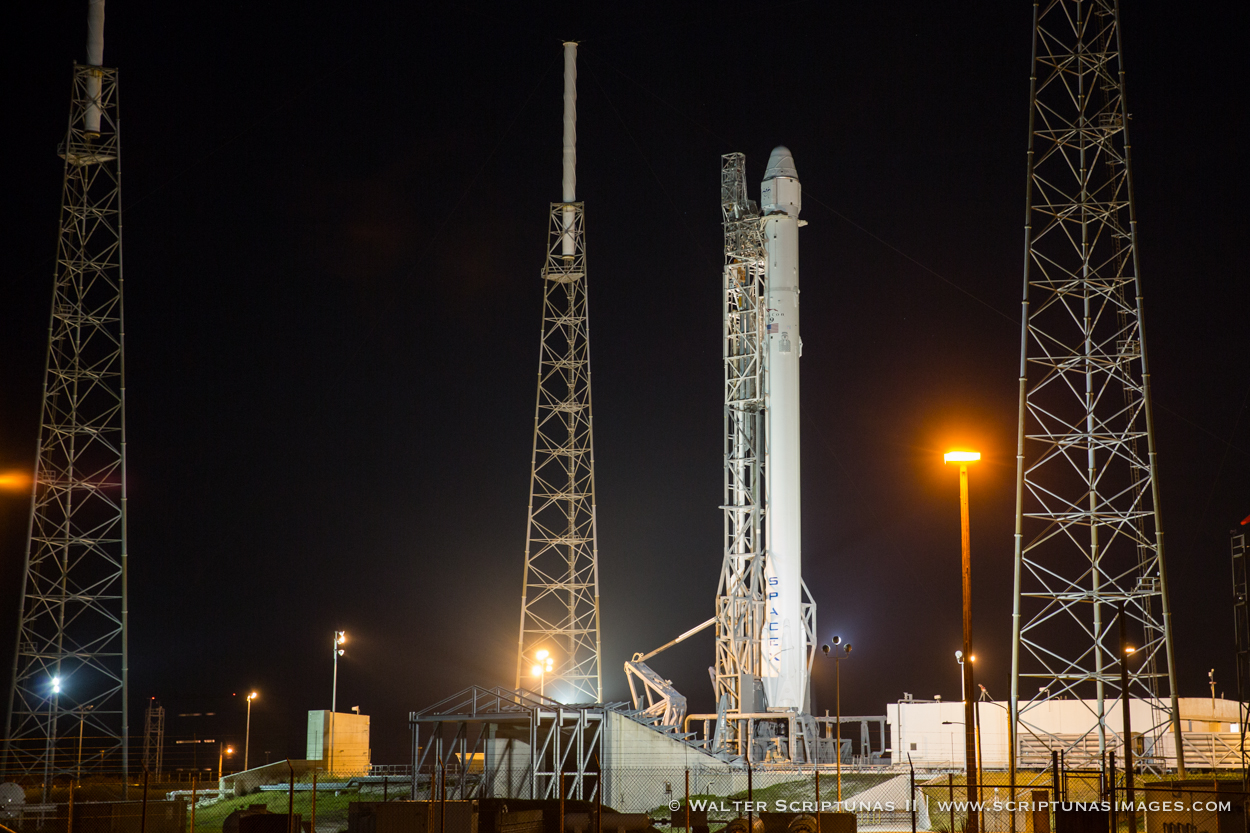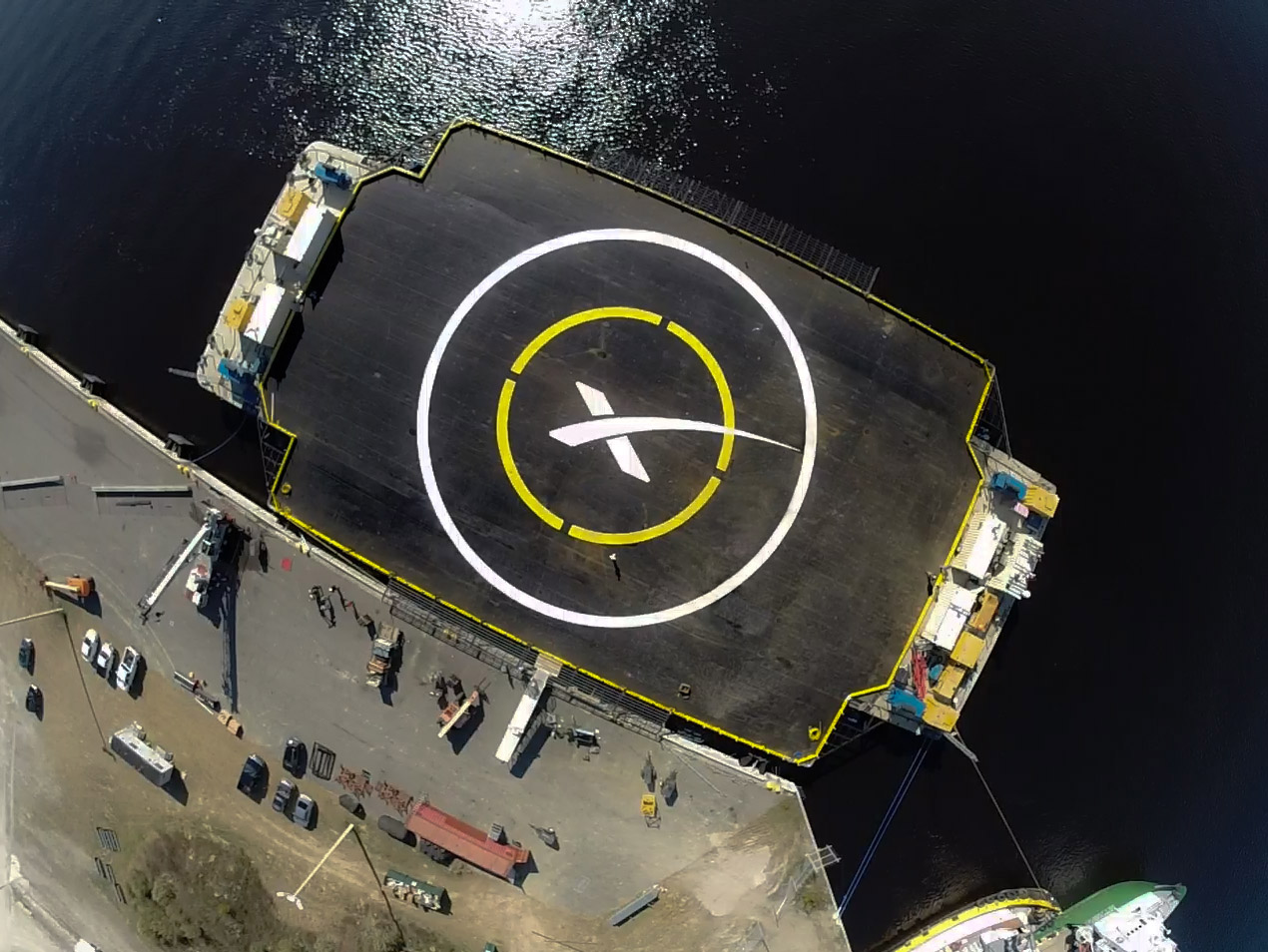The 208-foot-tall rocket is set for liftoff Tuesday at 6:20 a.m. EST (1120 GMT).

Posted on 01/05/2015 10:13:59 PM PST by Jack Hydrazine
SpaceX’s Falcon 9 rocket was lifted upright on Cape Canaveral’s Complex 40 launch pad Monday after workers loaded time-sensitive supplies and research specimens into the Dragon cargo craft’s pressurized cabin. More than 3,700 pounds of gear will be delivered to the International Space Station on the mission.
The 208-foot-tall rocket is set for liftoff Tuesday at 6:20 a.m. EST (1120 GMT).

Live launch coverage:
http://spaceflightnow.com/2015/01/05/spacex-5-mission-status-center/
http://www.spacex.com/webcast/
1430 GMT (9:30 a.m. EST)
Forecasters have improved the outlook for Tuesday’s launch opportunity at 6:20 a.m. EST (1120 GMT), with a 70 percent chance of favorable weather conditions now predicted.
“A frontal boundary has settled in over Central Florida,” the U.S. Air Force’s 45th Weather Squadron wrote in a forecast issued early Monday. “This front and its associated cloudiness will be very slow to move south of the Space Coast. With the clouds only slowly eroding overhead, the primary weather concern remains thick clouds.”
Forecasters predict scattered clouds at 2,000 feet and 12,000 feet, and a broken cloud deck at 24,000 feet for Tuesday’s predawn launch opportunity for SpaceX’s Falcon 9 rocket.
Officials are watching a sunspot on the Earth-facing side of the sun, but they do not expect any space weather launch criteria to be violated Tuesday.
The forecast calls for north-northeast winds of 5 to 10 mph, a temperature of around 64 degrees Fahrenheit, and good visibility.
The next launch attempt after Tuesday would likely come Friday, when there is an 80 percent chance of good weather.
“A strong push of cold air associated with a large high pressure area to the north will move the frontal boundary fully south of the spaceport on Wednesday,” Air Force forecasters said. “Winds will be northerly and brisk, ushering in cold air Thursday. On Friday winds veer and weaken, adding a slight risk of coastal showers. The primary weather concern for Friday is flight through precipitation.”
Ships deployed into the Atlantic for experimental rocket landing
http://spaceflightnow.com/2015/01/05/ships-deployed-into-the-atlantic-for-experimental-rocket-landing/

"But SpaceX's activities are certainly making the industry sit up.
It already offers commercial launch prices that undercut its competitors, and Europe has been so alarmed by the California company's progress that it has ordered a new, lower-cost version of its Ariane rocket."
SpaceX CRS-5
http://en.wikipedia.org/wiki/SpaceX_CRS-5
List of Falcon 9 launches
http://en.wikipedia.org/wiki/List_of_Falcon_9_launches
SpaceX reusable launch system development program
http://en.wikipedia.org/wiki/SpaceX_reusable_launch_system_development_program
http://en.wikipedia.org/wiki/Very_large_floating_structure#Floating_landing_platforms
Floating landing platforms
As of October 2014, Space Exploration Technologies (SpaceX) has contracted with a Louisiana shipyard to build a floating landing platform for reusable orbital launch vehicles. The initial platform will have an approximately 90 by 50 meters (300 ft × 160 ft) landing pad surface and will be capable of precision positioning with diesel-powered Azimuth thrusters[6] so the platform can hold its position for launch vehicle landing.
This platform is currently planned for first use in January 2015[7] when SpaceX plans to attempt a controlled descent flight test to land the first stage of Falcon 9 Flight 14 on a solid surface after it is used to loft a contracted payload toward Earth orbit.[8][9] The platform will utilize GPS position information to navigate and hold its precise position.[10] The rocket landing leg span is 18 m (60 ft) and must not only land within the 52 m (170 ft)-wide barge deck, but must also deal with ocean swells and GPS errors. SpaceX has projected that the likelihood of successfully landing on the platform on the first try is 50 percent or less.[11]
SpaceX CEO Elon Musk revealed a photograph of the “autonomous spaceport drone ship” in November 2014. The ship is designed to hold position to within 3 meters (9.8 ft), even under storm conditions.[12]
bookmark for the morning.
Thanks for the post!
Good morning, Jack. Can’t believe I’m actually up for this, but hey....it’s (supposedly) historic.
T-Minus 13:00 poll...GO for launch.
Whoever the PIO dude is on the mic, he doesn’t sound as ‘smooth’ as usual for a NASA launch.
Just showed a shot of the SpaceX launch control in Hawthorne, CA. Quite a crowd just outside the LCC.
Rocket gantry (”strongback”) retracted. T-4:00 and counting.
T- 2 minutes. Here we go.
Aw hell...HOLD HOLD HOLD. What happened?
Wow! To get that close and then abort.
Not sure what happened, but the LD called the hold with just a little more than 90 seconds to go. They’re going through the procedures to safe the vehicle. Still no word as to what caused the abort.
I know. Wonder what the problem was?
What the heck is “actuator drift”? That appears to be what stopped the count.
Next attempt at 5:09am Eastern on Friday, Jan 9.
Thanks for the ping.
Friday @ 0300 local. I’ll need to get up an hour early.
Disclaimer: Opinions posted on Free Republic are those of the individual posters and do not necessarily represent the opinion of Free Republic or its management. All materials posted herein are protected by copyright law and the exemption for fair use of copyrighted works.